Nikon GP-1 User Manual
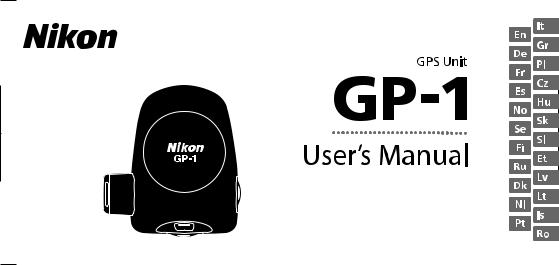
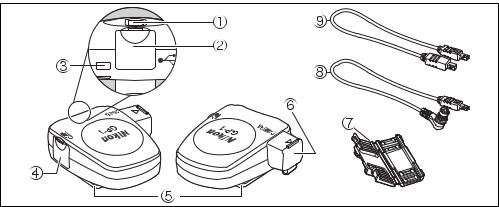

GPS Unit GP-1
User’s Manual
Table of Contents
For Your Safety |
2 |
En |
|
||
Notices............................................................. |
3 |
|
Introduction .................................................... |
4 |
|
The GP-1 and Supplied Accessories................. |
4 |
|
Parts of the GP-1 ............................................. |
5 |
|
Features of the GP-1........................................ |
5 |
|
Supported Cameras......................................... |
6 |
|
Turning the GP-1 on and O ............................ |
6 |
|
Connecting the GP-1 ....................................... |
7 |
|
Connecting the Optional MC-DC2.................... |
9 |
|
Mounting the GP-1 on the Camera.................. |
9 |
|
Recording GPS Data....................................... |
11 |
|
Notes on the GP-1.......................................... |
15 |
|
Precautions for Use ....................................... |
16 |
|
Specifications................................................ |
17 |
|
|
1 |
|

For Your Safety
En To prevent damage to your Nikon product or injury to yourself or to others, read the following safety precautions in their entirety before using this equipment. Keep these safety instructions where all those who use the product will read them.
•Do not disassemble: Touching the product’s internal parts could result in injury. In the event of malfunction, the product should be repaired only by a qualified technician. Should the product break open as the result of a fall or other accident, disconnect the device and take it to a Nikon-authorized service center for inspection.
•Keep dry: Do not immerse in or expose to water or handle with wet hands. Failure to observe this precaution could result in fire or electric shock.
•Do not use in the presence of flammable gas: Do not use electronic equipment in the presence of flammable gas, as this could result in explosion or fire.
•Keep out of reach of children: Failure to observe this precaution could result in injury.
•Request permission before using the device in an airplane or a medical facility: This device emits radio-frequency radiation that could interfere with navigational or medical equipment.
•Do not subject to high temperatures: Do not leave the device in areas subject to extremely high temperatures, such as in a closed vehicle on a hot day. Failure to observe this precaution could result in damage to the casing or internal circuitry, causing fire.
Notice for customers in Europe
This symbol indicates that this product is to be collected separately.
The following apply only to users in European countries:
•This product is designated for separate collection at an appropriate collection point. Do not dispose of as household waste.
•For more information, contact the retailer or the local authorities in charge of waste management.
2

Notices
Notices for Customers in the U.S.A.
Federal Communications Commission (FCC) Radio Frequency Interference Statement
This equipment has been tested and found to comply with the limits for a Class B digital device, pursuant to Part 15 of the FCC rules. These limits are designed to provide reasonable protection against harmful interference in a residential installation. This equipment generates, uses, and can radiate radio frequency energy and, if not installed and used in accordance with the instructions, may cause harmful interference to radio communications. However, there is no guarantee that interference will not occur in a particular installation. If this equipment does cause harmful interference to radio or television reception, which can be determined by turning the equipment o and on, the user is encouraged to try to correct the interference by one or more of the following measures:
•Reorient or relocate the receiving antenna.
•Increase the separation between the equipment and receiver.
•Connect the equipment to an outlet on a circuit di erent from that to which the receiver is connected.
•Consult the dealer or an experienced radio/TV technician for help.
En
CAUTIONS
Modifications
The FCC requires the user to be notified that any changes or modifications made to this device that are not expressly approved by Nikon Corporation may void the user’s authority to operate the equipment.
Notice for Customers in the State of California
WARNING: Handling the cord on this product will expose you to lead, a chemical known to the State of California to cause birth defects or other reproductive harm. Wash hands after handling.
Nikon Inc.,
1300 Walt Whitman Road, Melville, New York
11747-3064, U.S.A.
Tel.: 631-547-4200
Notice for Customers in Canada
CAUTION
This Class B digital apparatus complies with Canadian ICES-003.
ATTENTION
Cet appareil numérique de la classe B est conforme à la norme NMB003 du Canada.
3

Introduction
En Thank you for your purchase of a GP-1 GPS unit, a camera accessory that records the latitude, longitude, altitude, and Coordinated Universal Time (UTC) with your photographs (for a list of compatible cameras, see page 6). Be sure to read this manual thoroughly before use.
D Terminology
Function names di er from camera to camera. See your camera manual for details.
The GP-1 and Supplied Accessories
Confirm that the package contains the following items:
GP-1 GPS unit
GP1-CA10 cable for ten-pin remote terminals
GP1-CA90 cable for accessory terminals
GP1-CL1 strap adapter
Manual (this pamphlet)
Warranty
4
|
Parts of the GP-1 |
|
|
|
Features of the GP-1 |
|
||
|
|
|
|
|
|
|
|
|
|
Refer to the illustration inside the front cover of this |
|
When connected to a camera that supports GPS, the |
En |
||||
|
||||||||
|
manual. |
|
|
|
GP-1 records location information with photographs |
|||
|
LED ......................................................................................... |
11 |
|
|
(if desired, an optional MC-DC2 remote cord for re- |
|||
|
USB terminal...................................................................... |
18 |
|
mote shutter release can be connected via the GP-1). |
||||
Eyelet for strap (strap available separately; use cell phone strap or other similar strap)
Accessory terminal for optional MC-DC2 remote
cord .......................................................................................... |
9 |
Mount............................................................................... |
9, 10 |
Connection terminal for GP1-CA10 or |
|
GP1-CA90.......................................................................... |
7, 8 |
GP1-CL1 strap adapter................................................... |
10 |
GP1-CA10 cable for connection to cameras |
|
with ten-pin remote terminals...................................... |
7 |
GP1-CA90 cable for connection to cameras |
|
with accessory terminals ................................................. |
8 |
5

Supported Cameras
En The GP-1 can be used with the following cameras:
Camera |
Required cable |
|
|
D3, D700, D300, D2X, D2XS, D2HS, D200 |
GP1-CA10 |
|
|
D90 |
GP1-CA90 |
|
|
Turning the GP-1 on and O
The GP-1 is not equipped with a battery or on/o switch: power is supplied from the camera. The GP-1 turns o only when the cable connecting it to the camera is disconnected; even when the camera is o , the GP-1 continues to receive GPS data. For more information, see “Recording GPS Data” (page 13).
GP1-CA10 cable for ten-pin |
GP1-CA90 cable for |
remote terminals |
accessory terminals |
6
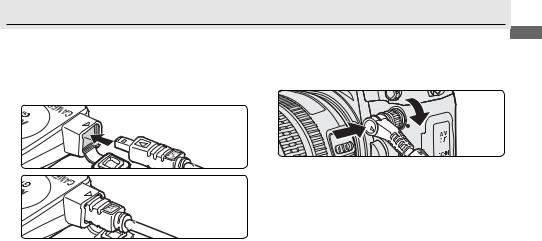
Connecting the GP-1 |
|
Page 1 of 2 |
|
Cameras with Ten-pin Remote Terminals |
3 |
Aligning the mark on the connector with the mark En |
|
1 |
Turn the camera o . |
|
on the camera body, insert the ten-pin connec- |
|
tor into the camera’s ten-pin remote terminal and |
||
2 |
Insert the GP1-CA10 cable ( ) into the connection |
|
tighten the locking nut. |
|
|
||
|
terminal ( ). |
|
|
Connecting the GP1-CA10 to a D3 digital camera
7
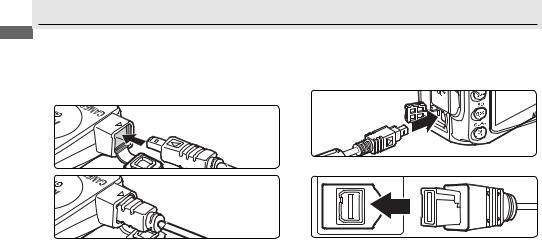
Connecting the GP-1 |
|
Page 2 of 2 |
|
En Cameras with Accessory Terminals |
3 |
Open the camera accessory terminal cover and |
|
1 |
Turn the camera o . |
|
insert the GP1-CA90 as shown. Be sure that the |
|
connector is in the correct orientation; do not use |
||
2 |
Insert the GP1-CA90 cable ( ) into the connection |
|
force. |
|
|
||
|
terminal ( ). |
|
|
Connecting the GP1-CA90 to a D90 digital camera
8
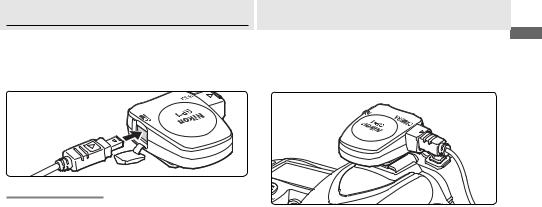
Connecting the Optional MC-DC2
An optional MC-DC2 remote cord for remote shutter release can be connected to the GP-1 accessory terminal ( ). When connecting the MC-DC2, be sure the connector is in the correct orientation; do not use force.
D Disconnecting the GP-1
Turn the camera o , disconnect the cable, and then replace the ten-pin terminal cap or close the accessory terminal cover.
Mounting the GP-1 on the Camera |
Page 1 of 2 |
En
The Camera Accessory Shoe
The GP-1 is equipped with a mount ( ) that fits the camera accessory shoe. Slide the GP-1 onto the camera accessory shoe as shown.
9
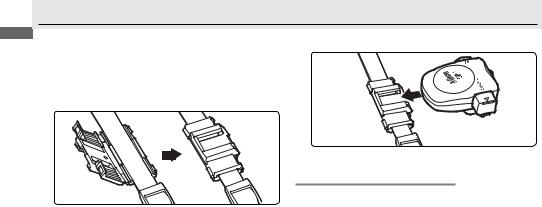
Mounting the GP-1 on the Camera |
Page 2 of 2 |
En Mounting the GP-1 on the Camera Strap |
2 Mount the GP-1 on the camera strap as shown ( ). |
The supplied strap adapter ( ) can be used to attach |
|
the GP-1 to the camera strap. |
|
1 Attach the strap adapter as shown. Do not attach |
|
the adapter where the strap is doubled. |
|
D Mounting the GP-1 on the Camera Strap
Note that the built-in GPS antenna may sometimes not be in the correct orientation when the GP-1 is mounted on the camera strap, and that signal quality may drop as a result.
10

|
Recording GPS Data |
|
|
|
|
|
|
|
|
|
|
|
Page 1 of 4 |
|
||||
|
|
|
|
|
|
|
|
|
|
|
|
|
|
|
|
|
|
|
1 |
Connect the GP-1 (page 7 , 8) and turn the camera |
|
|
|
|
|
En |
|||||||||||
|
LED |
O icon |
Status |
|
|
|||||||||||||
on. The GP-1 LED ( ) will light and a O icon will be |
|
|
|
|
|
|
||||||||||||
|
Blinks red |
Blinks |
GPS data not recorded. |
|
|
|||||||||||||
|
|
displayed in the control panel on top of the cam- |
|
|
||||||||||||||
|
|
|
|
|
|
|
|
|||||||||||
|
|
|
Blinks |
|
Three satellites detected; GPS |
|
|
|||||||||||
|
|
era. |
|
|
|
|
|
|
|
|
|
|
|
|||||
|
|
|
|
|
|
|
|
|
|
|
green |
|
data recorded. |
|
|
|||
|
|
|
|
|
|
|
|
|
|
|
|
|
|
On |
|
|||
|
|
|
|
|
|
|
|
|
|
|
|
|
|
|
|
|
|
|
|
|
|
|
|
|
|
|
|
|
|
|
|
|
On |
Four or more satellites detected; |
|
|
|
|
|
|
|
|
|
|
|
|
|
|
|
|
|
|
|
|||
|
|
|
|
|
|
|
|
|
|
|
|
|
|
(green) |
|
GPS data are more accurate. |
|
|
|
|
|
|
|
|
|
|
|
|
|
|
|
D The GPS Signal |
|
|
|
|
|
|
|
|
|
|
|
|
|
|
|
|
|
|
|
|
|
|
||
|
|
|
|
|
|
|
|
|
|
|
|
|
|
|
|
|
||
|
|
|
|
|
|
|
|
|
|
|
|
|
|
|
|
|
||
|
|
|
|
|
|
|
|
|
|
|
|
|
GPS data will be recorded only if the GP-1 is able to de- |
|||||
|
|
|
LED |
O icon (illustration shows |
tect three or more satellites. If no signal is received from |
|||||||||||||
|
|
|
|
|
control panel for the D90 |
the GP-1 for over two seconds, the O icon will no longer |
||||||||||||
|
|
|
|
|
|
|
|
digital camera) |
be displayed in the control panel and no GPS data will |
|||||||||
|
|
|
|
|
|
|
|
|
|
|
|
|
be recorded. |
|
|
|
|
|
11
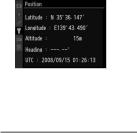
|
|
Recording GPS Data |
Page 2 of 4 |
||
|
|
|
|
|
|
En |
2 |
To view GPS data, select GPS > Position in the camera setup menu (this option is not available with D2X, |
|||
|
|||||
|
|
|
D2XS, D2HS, and D200 cameras). The current latitude, longitude, altitude, and Coordinated Universal Time |
||
(UTC) will be displayed (the example below shows the display for D90 digital cameras).
D Coordinated Universal Time (UTC)
The Coordinated Universal Time (UTC) received from the GPS satellite is recorded separately from the time provided by the camera clock.
12

Recording GPS Data |
Page 3 of 4 |
En
3 Take pictures. GPS data will be recorded with each photograph.
D Auto Meter O
If Enable is selected for GPS > Auto meter o in the setup menu for D3, D700, D300, and D90 cameras, the exposure meters will turn o automatically after the time specifi ed in the camera Custom Settings menu. This reduces the drain on the battery but may prevent GPS data from being recorded if the exposure meters are not activated until immediately before the picture is taken. Check that the O icon is displayed before shooting. The GP-1 periodically acquires GPS data when the camera or exposure meters are o , although the LED will not light. If no operations are performed for about three hours, the GP-1 will turn o .
When a D2X, D2XS, D2HS, or D200 camera is connected, or a D3, D700, D300, or D90 camera is connected with Disable selected for GPS > Auto meter o , the exposure meters will not turn o while the GP-1 is connected. The drain on the camera battery can be reduced by turning the camera o when not in use.
13
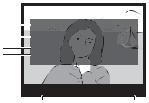
|
|
Recording GPS Data |
|
|
Page 4 of 4 |
||
|
|
|
|
|
|
|
|
En |
4 |
To view the GPS data recorded with each photo- |
|
GPS data for D90 digital cameras |
|||
|
|
||||||
|
|
|
graph, press the K button and display the pho- |
|
|
|
|
|
|
|
tographs full frame. The photo info display will |
1 |
LATITUDE. |
: N |
|
|
|
|
contain a page listing GPS data for the current |
2 |
|
: 35º 36. 371' |
|
|
|
|
LONGITUDE |
: E |
|||
|
|
|
photograph. |
3 |
|
: 139º 43. 696' |
|
|
|
|
ALTITUDE |
: 35m |
|||
|
|
|
|
4 |
TIME(UTC) |
: 2008/09/15 |
|
|
|
|
|
|
|
: 01:15:29 |
|
|
|
|
|
|
NI KON D90 |
12/12 |
|
|
|
|
|
|
5 |
6 |
|
|
|
|
|
Latitude |
Camera name |
||
|
|
|
|
Longitude |
Frame number/Total |
||
|
|
|
|
Altitude |
number of images |
||
|
|
|
|
Coordinated Universal |
|
|
|
|
|
|
|
Time (UTC) |
|
|
|
14

Notes on the GP-1
The GP-1 does not supply the compass heading. Local geographic and atmospheric conditions may prevent or En delay the acquisition of GPS data. The GP-1 may be unable to receive GPS data indoors, underground, or in the vicinity of large structures, trees, or other objects that block or reflect satellite signals. The positions of GPS satellites are continuously changing, preventing or delaying the acquisition of GPS data at certain hours of the day. The presence of cellular telephones or other devices that transmit on frequencies close to those of GPS satellites may also interfere with the acquisition of GPS data.
Note that the GP-1 may take several minutes to reacquire a signal if the unit has not been used for an extended period or has been moved a great distance since GPS data were last received.
15

Precautions for Use
En • Do not drop: The product may malfunction if subjected to strong shocks or vibration.
•Keep dry: This product is not waterproof, and may malfunction if immersed in or exposed to water.
•Avoid sudden changes in temperature: Sudden changes in temperature, such as occur when entering or leaving a heated building on a cold day, can cause condensation inside the device. To prevent condensation, place the device in a carrying case or plastic bag before exposing it to sudden changes in temperature.
•Keep away from strong magnetic fields: Do not use or store this device in the vicinity of equipment that generates strong electromagnetic radiation or magnetic fields. Strong static charges or the magnetic fields produced by equipment such as radio transmitters could a ect the product’s internal circuitry.
•A note on electronic devices: In extremely rare instances, a strong external static charge may cause the device to stop functioning. Turn the camera o and disconnect and reconnect the GP-1. In the event of continued malfunction, contact your retailer or Nikon-authorized service representative.
This product shall not be exported without authorization from the appropriate governmental authorities.
16

Specifications
|
|
|
|
En |
Supported cameras |
Nikon D3, D700, D300, D2X, D2XS, D2HS, D200, and D90 digital cameras |
|
|
|
Receiver |
Tracking channels: 18 (SBAS compliant) |
|
|
|
Acquisition times* |
Cold start: Approx. 45 s |
Hot start: Approx. 5 s |
|
|
Update rate |
Once per second |
|
|
|
Data format |
NMEA (National Marine Electronics Association) version 2.3 (compatible with version 3.01) |
|
||
Geodesics |
WGS84 |
|
|
|
GPS accuracy * |
Horizontal: 10 m/33 ft. RMS |
|
|
|
Interfaces |
Connection and accessory terminals, USB |
|
|
|
Average power consumption |
180 mW |
|
|
|
Operating temperature |
0 °C – 40 °C/32 °F – 104 °F |
|
|
|
Dimensions (W × H × D) |
Approx. 45.5 × 25.5 × 50 mm/1.8 × 1.0 × 2.0 in. |
|
|
|
Weight |
Approx. 24 g/0.85 oz. |
|
|
|
Length of cable |
Approx. 25 cm/10 in. (GP1-CA10 and GP1-CA90) |
|
|
|
|
|
|
|
|
Compatible accessories |
MC-DC2 remote cord (available separately) |
UC-E4 USB cable (supplied with digital SLR cameras) |
|
|
|
|
|
|
|
* Under open sky (no obstructions nearby)
17

En
Connecting the GP-1 to a Computer
The GP-1 can supply GPS data to a computer for use with mapping software and other applications. Connect the UC-E4 USB cable supplied with your digital camera to the GP-1 USB terminal ( ) and connect the cable to the computer. Power is supplied from the computer. Drivers for Windows XP and Windows Vista are available from the following Nikon websites, together with other information on using the GP-1 with a computer:
•For users in the U.S.A.: http://www.nikonusa.com/
•For users in Europe and Africa: http://www.europe-nikon.com/support
•For users in Asia, Oceania, and the Middle East: http://www.nikon-asia.com/
If the GP-1 is connected simultaneously to both a camera and a computer, GPS data will be supplied to the computer only.
18

GPS-Empfänger GP-1
Benutzerhandbuch
Inhaltsverzeichnis
Zu Ihrer Sicherheit........................................... |
2 |
|
Einleitung........................................................ |
4 |
De |
........Der GP-1 und das mitgelieferte Zubehör |
4 |
|
Bestandteile des GP-1 ..................................... |
5 |
|
Merkmale des GP-1 ......................................... |
5 |
|
Unterstützte Kameras..................................... |
6 |
|
Den GP-1 anund ausschalten ........................ |
6 |
|
Den GP-1 anschließen ..................................... |
7 |
|
Den optionalen MC-DC2 anschließen.............. |
9 |
|
Den GP-1 auf die Kamera montieren............... |
9 |
|
GPS-Daten aufzeichnen ................................ |
11 |
|
Hinweise für den GP-1................................... |
15 |
|
Vorsichtsmaßnahmen................................... |
16 |
|
Spezifikationen ............................................. |
17 |
|
|
1 |
|

|
Zu Ihrer Sicherheit |
Seite 1 von 2 |
|
|
|
|
|
Um Schäden an Ihrem Nikon-Produkt zu vermeiden sowie Verletzun- De gen zu verhindern, lesen Sie bitte die folgenden Sicherheitshinweise, bevor Sie das Gerät verwenden. Bewahren Sie diese Sicherheitshinwei-
se so auf, dass alle Benutzer des Produktes sie lesen werden.
•Nicht auseinanderbauen: Das Berühren interner Teile des Produkts kann zu Verletzungen führen. Im Falle einer Fehlfunktion sollte das Gerät nur von einem qualifizierten Techniker repariert werden. Falls das Produkt durch Herunterfallen oder einen anderen Unfall aufgebrochen ist, stecken Sie das Gerät ab und lassen Sie es von einem Nikon-Kun- dendienst-Center überprüfen.
•Trocken halten: Vermeiden Sie den Kontakt mit Wasser und die Bedienung mit nassen Händen. Ein Missachten dieser Vorsichtsmaßnahme kann einen Stromschlag oder einen Brand zur Folge haben.
•Nicht in der Nähe von entflammbaren Gasen benutzen: Die Verwendung elektronischer Geräte in der Nähe von entflammbarem Gas kann zu Explosionen oder Bränden führen.
•Von Kindern fernhalten: Ein Missachten dieser Vorsichtsmaßnahme kann zu Verletzungen führen.
•Vor der Nutzung in Flugzeugen oder medizinischen Einrichtungen um Erlaubnis fragen: Dieses Gerät sendet hochfrequente Strahlung aus, die Navigationsinstrumente oder medizinische Ausrüstung stören kann.
•Keinen hohen Temperaturen aussetzen: Lassen Sie das Gerät nicht an Orten liegen, wo es extrem hohen Temperaturen ausgesetzt sein könnte, beispielsweise an einem heißen Tag in einem geschlossenen Fahrzeug. Ein Missachten dieser Vorsichtsmaßnahme kann zu Schäden am Gehäuse oder den internen Schaltkreisen führen. Dies kann Brände verursachen.
2

Zu Ihrer Sicherheit
Hinweis für Kunden in Europa
Durch dieses Symbol wird angezeigt, dass dieses Produkt getrennt entsorgt werden muss.
Folgendes gilt für Verbraucher in europäischen Ländern:
•Dieses Produkt muss an einer geeigneten Sammelstelle separat entsorgt werden. Eine Entsorgung über den Hausmüll ist unzulässig.
•Weitere Informationen erhalten Sie bei Ihrem Fachhändler oder bei den für die Abfallentsorgung zuständigen Behörden bzw. Unternehmen.
Seite 2 von 2
De
3

Einleitung
Vielen Dank für den Kauf des GP-1. Dieser GPS-Empfänger De ist ein Kamerazusatz, der den Breitenund Längengrad, die Höhe sowie die Weltzeit (UTC) Ihrer Fotos aufzeichnet (Eine Liste mit kompatiblen Kameras befindet sich auf Seite 6). Bitte lesen Sie dieses Handbuch vor der Benutzung
sorgfältig.
DTerminologie
Die Funktionsbezeichnungen können sich von Kamera zu Kamera unterscheiden. Für weitere Informationen ziehen Sie bitte das Handbuch Ihrer Kamera hinzu.
Der GP-1 und das mitgelieferte Zubehör
Überprüfen Sie, ob die Packung die folgenden Teile enthält:
GPS-Empfänger GP-1
GP1-CA10-Kabel für 10-poligen Anschluss
GP1-CA90-Kabel für Zubehöranschluss
GP1-CL1-Trageriemen-Adapter
Handbuch (dieses Heft)
Garantie
4

Bestandteile des GP-1 |
|
Siehe Grafik auf der Innenseite des Handbuchdeckblatts. |
|
LED................................................................................................ |
11 |
USB-Anschluss.......................................................................... |
18 |
Öse für Trageriemen (Trageriemen ist separat erhältlich; verwenden Sie den Trageriemen ihres Mobiltelefons oder einen ähnlichen Riemen)
Zubehöranschluss für den optionalen
Kabelfernauslöser MC-DC2................................................... |
9 |
Objektivanschluss ............................................................. |
9, 10 |
Anschlusspol für GP1-CA10 oder GP1-CA90 .............. |
7, 8 |
GP1-CL1-Trageriemen-Adapter ......................................... |
10 |
GP1-CA10-Kabel für die Verbindung zu Kameras mit |
|
10-poligem Anschluss............................................................. |
7 |
GP1-CA90 für die Verbindung zu Kameras mit Zube- |
|
höranschluss............................................................................... |
8 |
Merkmale des GP-1
Sobald der GP-1 an eine Kamera angeschlossen wird, die GPS unterstützt, zeichnet er Ortsinformationen zu den De Fotos auf (falls gewünscht, kann optional der Kabelfernauslöser MC-DC2 über den GP-1 angeschlossen werden).
5

Unterstützte Kameras
Der GP-1 kann mit folgenden Kameras benutzt werden:
De
Kamera |
Benötigtes Kabel |
D3, D700, D300, D2X, D2XS, D2HS, D200 |
GP1-CA10 |
D90 |
GP1-CA90 |
Den GP-1 anund ausschalten
Der GP-1 besitzt keinen Akku oder An/Aus-Schalter: Die Stromversorgung erfolgt über die Kamera. Der GP-1 schaltet sich nur ab, wenn das Verbindungskabel zur Kamera getrennt wird. Selbst wenn die Kamera abgeschaltet ist, empfängt der GP-1 weiter GPS-Daten. Für weitere Informationen, siehe »GPS-Daten aufzeichnen« (Seite 13).
GP1-CA10-Kabel für |
GP1-CA90-Kabel für |
10-poligen Anschluss |
Zubehöranschluss |
6
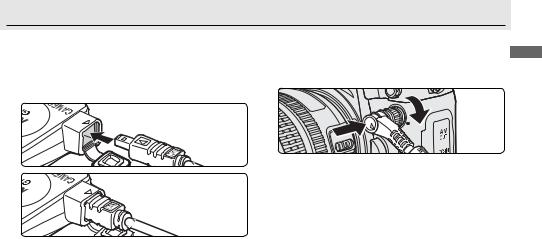
Den GP-1 anschließen |
|
Seite 1 von 2 |
|
Kameras mit 10-poligem Anschluss |
3 |
Richten Sie die Markierung des Steckers an der Mar- |
|
1 |
Schalten Sie die Kamera aus. |
|
kierung des Kameragehäuses aus. Stecken Sie den De |
|
10-poligen Stecker in den 10-poligen Anschluss und |
||
2 |
Stecken Sie das Kabel GP1-CA10 ( ) in den Anschluss- |
|
befestigen Sie die Sicherungsmutter. |
|
|
||
|
pol ( ). |
|
|
Das GP1-CA10 an eine D3-Digitalkamera anschließen
7
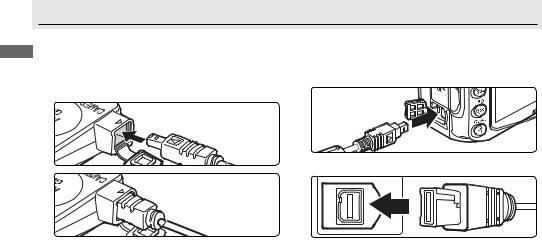
Den GP-1 anschließen |
|
Seite 2 von 2 |
|
Kameras mit Zubehöranschluss |
3 |
Ö nen Sie den Deckel des Zubehöranschlusses und |
|
De |
|
|
verbinden Sie das GP1-CA90 wie abgebildet. Achten |
1 |
Schalten Sie die Kamera aus. |
|
Sie auf die richtige Ausrichtung des Steckers und wen- |
2 |
Stecken Sie das Kabel GP1-CA90 ( ) in den Anschluss- |
|
den Sie keine Gewalt an. |
|
|
||
|
pol ( ). |
|
|
Das GP1-CA90 an eine D90 anschließen
8
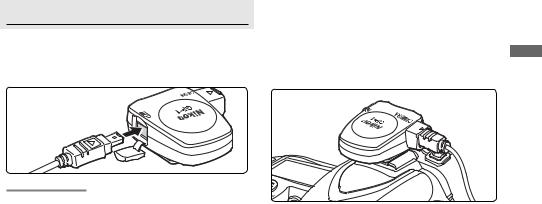
Den optionalen MC-DC2 anschließen
Der optionale Kabelfernauslöser MC-DC2 kann über den Zubehöranschluss des GP-1 angeschlossen werden ( ). Achten Sie auf die richtige Ausrichtung des Steckers, wenn sie den MC-DC2 anschließen. Wenden Sie keine Gewalt an.
DDen GP-1 abstecken
Schalten Sie die Kamera aus und entfernen Sie das Kabel. Setzen Sie den Deckel wieder auf den 10-poligen Anschluss oder schließen sie die Anschlussabdeckung des Zubehöranschlusses.
Den GP-1 auf die Kamera montieren |
Seite 1 von 2 |
||
|
|
|
|
Der Kamera-Zubehörschuh
Der GP-1 besitzt einen Objektivanschluss ( ), der auf den De Zubehörschuh passt. Schieben Sie den GP-1 auf den Zubehörschuh der Kamera wie abgebildet.
9

|
|
Den GP-1 auf die Kamera montieren |
|
Seite 2 von 2 |
||
|
|
|
|
|
|
|
|
|
Den GP-1 am Trageriemen befestigen |
2 |
Befestigen Sie den GP-1 am Trageriemen der Kamera |
||
De |
wie abgebildet ( ). |
|||||
|
Mit dem mitgelieferten Trageriemen-Adapter ( ) kann |
|
||||
der GP-1 am Trageriemen der Kamera befestigt werden.
1 |
Befestigen Sie den Adapter wie abgebildet. Bitte brin- |
|
gen Sie den Adapter nicht an den doppelt liegenden |
Stellen des Trageriemens an.
DDen GP-1 am Trageriemen befestigen
Die integrierte GPS-Antenne kann manchmal falsch ausgerichtet sein, wenn der GP-1 am Trageriemen befestigt ist. Die Signalqualität kann dadurch beeinträchtigt werden.
10
